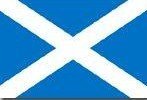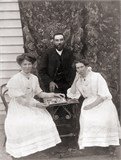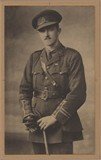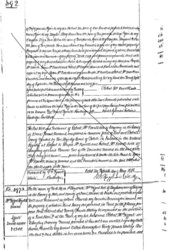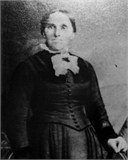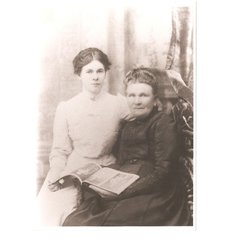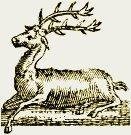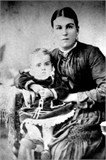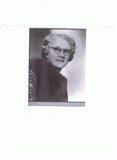Maxwell
The origins of the name are very ancient. Maccus, son of Undwyn, a Saxon, came to the area and set up home in his 'ton' at Maccuston - modern day Maxton. He and his family were signatories to various documents, and one of his sons became Sheriff of Roxburghshire. Maccus was granted land at Kelso to the south of the town of Easter Kelso about turn of the twelfth century. There was on his land an excellent salmon pool in the Tweed, which became known as Maccus' wiel - Maccus' pool - hence Maxwheel or Maxwell. The Parish of Maxwell, where Springwood Park and the Border Union Showground are today, was a separate parish in early medieval times. The land above, Maxwellheugh, and Maxwell Lane continue the name in the town. The family name of Maxwell is well-known throughout the South of Scotland
The Maxwells are a Border clan and were active during the turbulent Border wars. The first leader was Maccus, son of Undweyn who lived in the 12th Century who appears to have given his name to Maccuswell, a pool of the Tweed near Kelso Bridge; Wael is old English for pool. His descendant Sir John Maxwell was appointed Chamberlain of Scotland but died without issue in 1241. He was the first to occupy the Maxwell's great castle of Caerlaverock. He was succeeded by his brother Sir Aymer who had two sons, Herbert and John. From these two brothers descend many branches of the Maxwell clan. Sir Herbert of Maxwell was one of the nobles who recognized Margaret of Norway as Queen of Scots and John Balliol as King. His grandson,Sir Eustace held Caerlaverock for Edward I in 1312 but later signed The Decalaration of Arbroath in 1320. He returned to Balliol's camp briefly but then followed the Bruces, his brother and son also followed David II to the field in 1346.Herbert his successor was knighted Lord Maxwell afterJames I return in 1424 and he became increasingly more powerful during the 15th century after the decline of the Black Douglases and became Warden of the Marches. John, Lord Maxwell in the reign of King James IV was imprisoned for lawlessness but later died with his King at Flodden in 1513. He had two sons, Robert, 5th Lord and John who became Lord Herries of Terregles by marrying Lady Anne Herries. His brother served briefly as Regent during King James V's reign and escorted Queen Mary of Lorraine to Scotland in 1538. In 1581, John, Lord Maxwell was created Earl of Morton after the execution of the Douglas holder, he was killed in an engagement with the Johnstons in 1593. His son also John, in revenge killed Sir James Johnston of that Ilk in 1608 and fled to the continent, only to be executed on his return in 1613. He was succeeded by his brother Robert who was created Earl of Nithsdale (the title of Earl of Morton was restored to the Douglases). The title reverted to Lord Herries when the direct line ended. The 5th Earl joined the Jacobite Rising of 1715 and was captured and sentenced to death, he escaped from the Tower of London dressed in female attire and then he escaped to Rome where he was forced to live in poverty until his death. Other Maxwell families include those of Pollock, Monreith, Cardoness and Corruchan. William Maxwell of Corruchan established in Lyon Court his claim as heir male of the Maxwells.
In their illustrious history, the Maxwells have held numerous titles and offices, such as Earl of Nithsdale, Earl of Morton, Earl of Dirleton, Lords Maxwell, Carlyle, Elbottle, Eskdale, Herries of Terregles, Kingston, Farnham and DeRos. They have held five baronetcies: that of Calderwood in Lanarkshire, Cardoness in Kirkcudbrightshire, Monreith in Wigtonshrie, Pollock of Renfrewshire and Springkell in Dumfriesshire. Maxwells were Wardens of the West March of the Scotland/English border
Many were the castles and estates that belonged to the Maxwells over the centuries, such as Threave, Annan Tower, Lochmaben, Langhol, Hills, Terregles, Maxwell's Castle (Dumfries), Barend, Kirkconnell, Hoddom, Cardoness, Orchardtown, Corra, Preston (Wrieth's Tower), Castlemilk, Cowhill, Fourmerkland, The Isle, Friar's Carse, Myretown Tower, Auldhouse, Monreith, and in Strathclyde there was Pollock, Hags, Calderwood, Newark, Stainley, and Dargavel House. However, the great castle of the Maxwells and their Clan seat is Caerlaverock Castle, south of Dumfries on the Solway, a unique and awesome sight even in its partial state of ruin today!
With the union of the crowns of Scotland and England in 1605, many Maxwells along with other Scots moved south into England. The eighteenth century saw many Maxwells dispersed throughout the British Empire.
All the Maxwell families who live in Ireland or who ever have lived in Ireland, have their origins in Scotland. Many of these Maxwells forebears went there during the 17th century and have long forgotten their Scottish
roots.
Since earliest times, the Maxwell family enjoyed a mobility accorded only to the nobility and merchant classes. Their castle at Caerlaverock on the Solway had its own port and one must assume that the early Maxwells travelled within the Irish Sea trading triangle that linked the east coast of Ireland with the north-west coast of England and the south-west of Scotland. From both the Galloway coast and the Clyde estuary, Maxwells are likely to have traded with the Celtic people on the Irish mainland
One of the Maxwells who lived in Ireland was the Reverend Robert Maxwell, a younger son of Maxwell of Calderwood. He went to Ireland late in the reign of Queen Elizabeth and lived within the English pale. When King James VI of Scotland came to the English throne in 1603, Robert Maxwell was made Dean of Armagh. From Robert, the Maxwells of Farnham, Finnebrogue, Ballyrolly and Killyleagh are all descended.Other Maxwells to go to ireland were hugh Maxwell who fled the Jacobites in 1715 he went to co Down with his three sons and farmed at carrick hills Hugh was married to Mary Meinzies who was also born at dumfries, but I do not at this
stage in my research know if she accompanied them to Ireland.
I AM IN POSSESSION ,HAVING PURCHASED THE MCGIFFERT LETTERS WRITTEN TO DAVID MCGIFFERT IN ALABAMA BY COUSINS OUR
ANCESTORS IN IRELAND . WRITTEN BY THE SIBLINGS OF ELIZABETH MCGIFFERT/MAXWELL TO THEIR BROTHER WHILE HE WAS IN MELBOURNE AND CALIFORNIA. ALSO MANY LETTERS WRITTEN TO DAVID MCGIFFERT THEIR COUSIN LETTERS ALSO WRITTEN BY ISABELLA RACHEL JANE MCGIFFERT TO BROTHER WILLIAM (BILL) WHILE HE WAS ON THE CALIFORIAN GOLDFIELDS. STRANGLEY NO LETTER WAS WRITTEN TO OR BY OUR ANCESTOR ELIZABETH (ELIZA) MCGIFFERT/MAXWELL.
CHILDREN OF THEIR UNCLE JAMES MCGIFFERT THEIR FATHER BEING WILLIAM MCGIFFERT AND MARY THEIR MOTHER.
LOOK AT THE PEOPLE THAT I HAVE MENTIONED TO GET A VERY SHORT SUMMARY OF EACH LETTER AND THE CONTENTS OF THEM
WALKING, I AM LISTENING
TO A DEEPER WAY.
SUDDENLY, ALL MY
ANCESTORS ARE BEHIND ME.
BE STILL, THEY SAY.
WATCH AND LISTEN.
YOUR ARE THE RESULT OF
THE LOVE OF THOUSANDS.
~ Linda Hogan

